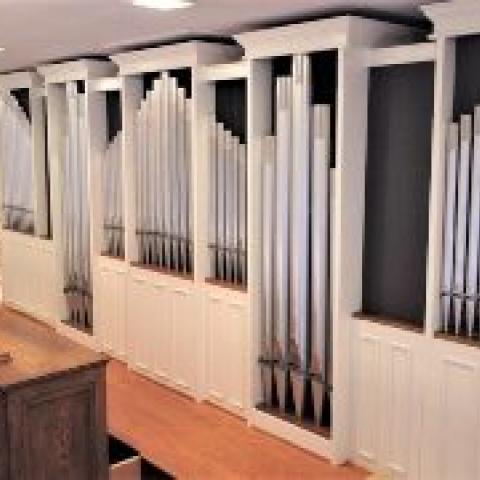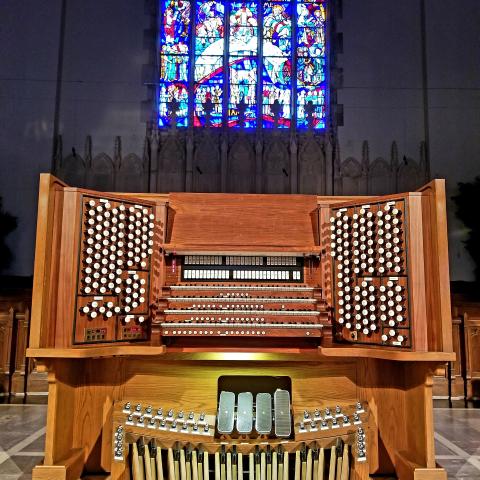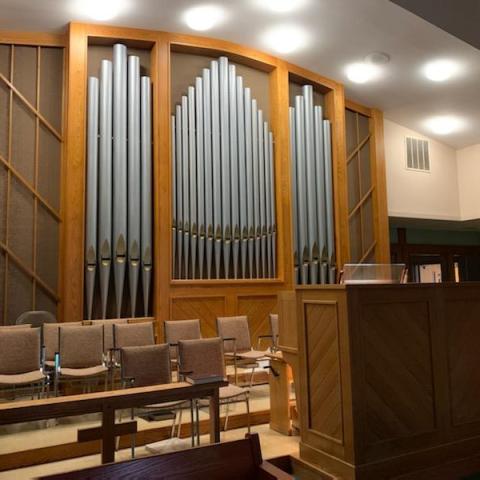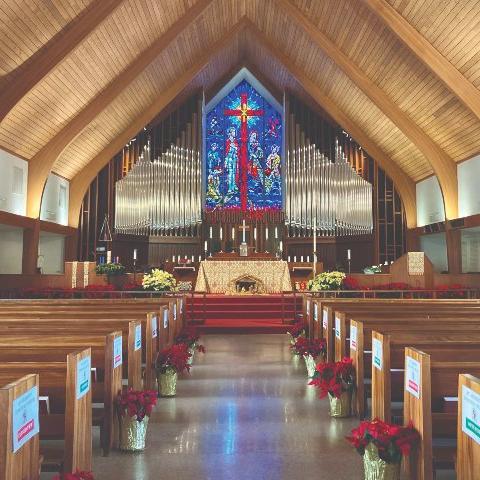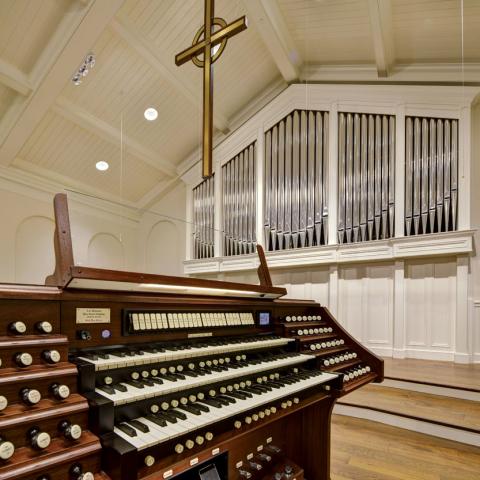
Flentrop Orgelbouw, Zaandam, Netherlands
Dypvåg kirke, Tvedestrand, Norway
The work of Arp Schnitger was the inspiration for the new Flentrop organ in Dypvåg kirke, best suited for seventeenth- and eighteenth-century music and with a warm and colorful sound. The organ has two windchests, positioned one behind the other—a seventeenth-century solution—to save space, two wedge bellows, a stable but flexible wind supply, and a small pedal division behind the main case.
The pipe metal was cast on sand. The key and stop actions are mechanical, the manual action suspended. The case is oak with hand carved ornaments, the naturals of boxwood, the sharps of oak with ebony covers. The stopknobs are ebony. The instrument’s inauguration was played by church organist Hans van der Meijden on October 20, 2019.
This organ is a treasure that must be played by skillful hands. Its specific style and very limited size require the organist to be creative in his or her registrations and sensitive to explore the beauty it contains. But when played with this care, the instrument will reward the organist and the congregation with a sound quality that touches the heart.
—Erik Winkel, managing director, Flentrop Orgelbouw
Hauptwerk (Manual I, CD–d′′′)
8′ Principal
8′ Gedact
4′ Octav
3′ Nasat
2′ Octav
Hinterwerk (Manual II, CD–d′′′)
8′ Quintaden
4′ Gedact
3′ Quinta
2′ Waltfloit
11⁄2′ Sifloit
Sexquialter II
Mixtur B/D IV
16′ Dulcian B/D
8′ Trommet B/D
8′ Vox Humana
Pedal (CD–d′)
16′ Untersatz
16′ Posaune
Accessories
Tremulant
Cimbelstern
Vogelgeschrei
Couplers
Hinterwerk + Hauptwerk (shove coupler)
Pedal + Hauptwerk
Pedal + Hinterwerk
a1 = 440 Hz at 18 degrees C
Temperament: Kellner-Bach
wind pressure: 70mm
Builder’s website: www.flentrop.nl.
Learn more about the church here: https://en.wikipedia.org/wiki/Dypv%C3%A5g_Church.
Photo: Dypvåg kirke, Tvedestrand, Norway, Flentrop organ (photo credit: Dannevig Foto)
Michael Proscia Organbuilder, Inc., Bowdon, Georgia
Alps Road Presbyterian Church, Athens, Georgia
Michael Proscia Organbuilder, Inc., has completed an organ rebuilding project for Alps Road Presbyterian Church, Athens, Georgia. In 1982, the church (then known as Central Presbyterian Church) commissioned the Schantz Organ Company to provide an organ to be completed the following year. The instrument of 22 ranks with preparation for future additions included a two-manual, all-electric drawknob console. The exposed Great division was divided on either side of the chancel, with the Swell division to the right and Pedal division to the left as one faces the altar. The chambers are very generous in size with tonal egress on the long side via unobstructed openings, speaking directly into the chancel. The sanctuary contains some sound absorbing materials (pew cushions and carpeting); however, its rectangular shape, high ceiling, and generous size, allows the organ full bloom into the room.
From the beginning of our association with the church and organist Emma Pettyjohn (April 2011), we recommended completing the prepared-for additions, including replacing the mechanical combination action with solid-state components. As time went on, notwithstanding the fine craftsmanship of the Schantz company, some of the console switches and preset controls became defective and, inasmuch as these were now becoming obsolete, became increasingly difficult to replace. This (and other planned chancel changes) motivated the church to begin a concise, overall improvement project.
Our original intention was to complete the project as outlined above; however, fate intervened and an opportunity to go beyond previous recommendations presented itself. Rather than retaining the extant two-manual console, we suggested a rebuilt, three-manual console be provided along with another division for the first keyboard, specifically a new Positiv. As further incentive, we agreed to provide (at no cost) an eight-bell Cymbalstern, Chimes, and two ranks for the Great division. After some negotiations and recommendation from Dr. Pettyjohn to the church’s Session, we received an enthusiastic “go for it!”
We obtained a Schantz electro-pneumatic, three-manual, drawknob console, built in 1972, from another client after providing that client with a rebuilt, all-electric, three-manual console with solid-state control from our inventory that better suited that space rather than retrofitting their extant console. The 1972 Schantz console was provided with ivory key tops, a luxury now unobtainable, and was further motivation for us to provide Alps Road Presbyterian Church a console with elegance.
We provided side jamb rocker tablets rather than drawknobs. The console shell, bench, roll top, and pedalboard frame were brought to a local furniture restoration company that had done similar work for us with very pleasing results. The new coupler/combination action and organ control relay was provided by Peterson Electro-Musical Products, Inc. Worn pedal keys and contacts were replaced with new components along with a portable platform, donated by our firm. The departure from a set, permanent position of the previous console allows for traditional service placement and concert position for recitals, etc., part of the chancel reconfiguration process.
Fortuanately, in February 2020, just before the outbreak of the pandemic in the United States, the instrument was rededicated as part of an annual church celebration. The event was well attended with a program that “pulled out all the stops” including an organ recital by Dr. Pettyjohn, choir, and handbell ringers.
Shop personnel: Corley Easterling, Jesse Caldwell, Mack Hudson, and Michael Isham.
The Proscia firm offers special thanks to several church volunteers and Marvin Pettyjohn, without whose faithful help the project would not have moved along so smoothly.
—Michael Proscia, president
GREAT
8′ Principal 61 pipes
8′ Bourdon 61 pipes
8′ Holz Gedeckt* 61 pipes
8′ Gemshorn (in Sw box) 61 pipes
4′ Octave 61 pipes
4′ Nachthorn* 61 pipes
2′ Blockfloete 61 pipes
1-1⁄3′ Mixture IV 244 pipes
8′ Krummhorn (in Sw box) 61 pipes
Chimes* (24 tubes)
Gt/Gt 4
Gt Unison Off
Sw/Gt 16-8-4
SWELL
16′ Rohr Bourdon (ext 8′) 12 pipes
8′ Viole da Gamba 61 pipes
8′ Viole Celeste (TC) 49 pipes
8′ Rohr Bourdon 61 pipes
4′ Principal 61 pipes
4′ Koppelfloete 61 pipes
2-2⁄3′ Nasat* 61 pipes
2′ Octave 61 pipes
1-3⁄5′ Terz* 61 pipes
1-1⁄3′ Quinte 61 pipes
1′ Scharff III (draws Quinte) 122 pipes
8′ Trompette 61 pipes
4′ Oboe Clarion 61 pipes
Tremulant
Sw 16-Unison Off-4
POSITIV*
8′ Quintade 61 pipes
8′ Salizional 61 pipes
4′ Copula 61 pipes
2′ Principal 61 pipes
1′ Super Octave (ext 2′) 12 pipes
2′ Mixture III 183 pipes
8′ Rohr Schalmey 61 pipes
Sw/Pos 8-4
PEDAL
32′ Faux Bourdon (resultant)
16′ Principal (ext 8′ Princ) 12 pipes
16′ Brummbass 32 pipes
16′ Quintaton (ext, Pos) 12 pipes
16′ Rohr Bourdon (Sw)
8′ Principal 32 pipes
8′ Rohr Bourdon (Sw)
4′ Choral Bass 32 pipes
4′ Nachthorn (Gt)
2′ Octave (ext 4′ Chor Bass) 12 pipes
16′ Contra Trumpet (ext, Sw) 12 pipes
8′ Trompette (Sw)
4′ Rohr Schalmey (Pos)
Gt/Ped 8-4
Sw/Ped 8-4
Pos/Ped 8
Reversibles
Gt/Ped
Sw/Ped
Pos/Ped
Sfz
Cymbalstern*
* additions by Proscia
42 stops, 36 ranks, 2,167 pipes

